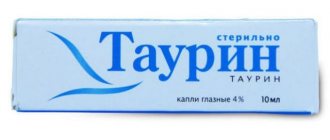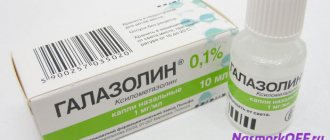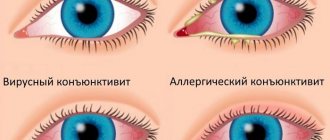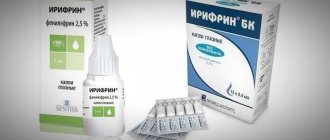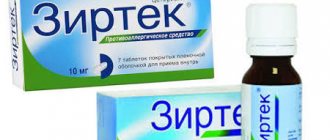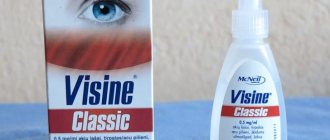Tobradex is a combination drug used locally in ophthalmology, which has anti-inflammatory and antimicrobial effects.
It has this effect due to the content of a glucocorticosteroid (dexamethasone) and a broad-spectrum antibiotic (thoramycin).
In this article we will look at why doctors prescribe Tobradex, including instructions for use, analogues and prices for this drug in pharmacies. Real REVIEWS of people who have already used Tobradex can be read in the comments.
Composition and release form
The drug Tobradex is produced in the form of:
- Eye drops (white suspension) containing 3 mg of tobramycin and 1 mg of dexamethasone in 1 ml;
- White homogeneous ophthalmic ointment containing 3 mg of tobramycin and 1 mg of dexamethasone.
Active substance:
- For Tobradex eye drops: tobramycin - 3 mg, dexamethasone - 1 mg.
- Excipients: benzalkonium chloride, disodium edetate, sodium chloride, anhydrous sodium sulfate, tyloxapol, hydroxyethylcellulose, sulfuric acid or sodium hydroxide, purified water.
Clinical and pharmacological group: a drug with antibacterial and anti-inflammatory effects for topical use in ophthalmology.
The effect of the drugs "Tobradex", "Dexamethasone", "Tobrazon" and "Dexatobropt"
"Tobradex" is a combination drug that is used to treat the eyes. Tobramycin, which is included in its composition, is considered a broad-spectrum antibiotic. It belongs to the group of aminoglycosides and has a high degree of activity against gram-positive and negative microorganisms.
Dexamethasone is a hormone. It has an anti-inflammatory antiallergic effect. Removes swelling and hyperemia. It is used only locally, so it does not enter the bloodstream.
Like Tobradex (eye drops), cheap analogues also give a good effect in treatment. However, you should consult your doctor first. Drops “Tobrazon”, Dexomitazon”, “Dexatobropt”, like any other drugs, are not suitable for self-medication. A diagnosis must be made initially.
pharmachologic effect
Tobradex is a combination drug containing corticosteroid and antimicrobial components. The drug has a pronounced anti-inflammatory and bactericidal effect. The drug Tobradex contains two active components - dexamethasone and tobramycin.
- Tobradexa is an antibiotic (tobramycin), it has a wide spectrum of action - it effectively destroys almost all strains of microorganisms that cause inflammatory processes in the eyes.
- Dexamethasone (another active substance) is a corticosteroid and has an anti-inflammatory effect.
Tobradex has an antiexudative effect. When applied topically, absorption of active components is low.
Instructions for use of Tobradex drops, dosage
Eye drops are intended for instillation into the conjunctival sac.
Before using the drug, it is recommended to thoroughly wash your hands and shake the bottle until an equilibrium suspension is formed.
The standard dosage of Tobradex eye drops, according to the instructions for use, is from 1 to 2 drops every 4-6 hours. If you miss the next dose of the drug, you should use the drops as soon as possible; if there is less than 1 hour left before the scheduled use of the next dose, the dose that was forgotten is skipped. It is not recommended to double the dosage.
The duration of the course of treatment usually does not exceed 5-7 days, but if the symptoms of the disease persist, the instructions recommend seeking advice from an ophthalmologist.
To reduce the likelihood of developing systemic adverse reactions (by reducing systemic absorption of the drug), after instillation of Tobradex, it is recommended to apply light pressure with a finger at the inner corner of the eye on the area of projection of the lacrimal sacs for 1–2 minutes.
If therapy is carried out longer than 14 days, monitoring of the condition of the cornea is required.
Side effects
The instructions warn about the possibility of developing the following side effects when prescribing Tobradex eye drops:
- swelling of the eyelids;
- hyperemia of the mucous membrane of the eyes;
- feeling of “sand” in the eyes;
- blurred vision, blurred vision;
- itching and burning in the eyes after instilling the drug;
- increased intraocular pressure (due to dexamethasone included in the drug);
- cataract formation.
The appearance of non-healing ulcers on the cornea after long-term treatment with GCS may indicate the development of a fungal infection.
In addition, patients with scleral thinning may develop perforation (the risk increases with prolonged use). The development of a secondary infection (caused by microorganisms insensitive to the action of tobramycin) cannot be ruled out.
Contraindications
Tobradex is contraindicated in the following cases:
- viral diseases of the cornea and conjunctiva (including keratitis caused by herpes, chicken pox);
- mycobacterial eye infection;
- fungal eye diseases;
- conditions after removal of a corneal foreign body;
- children under 12 years of age;
- lactation period;
- hypersensitivity to any component of the drug.
Pregnant women are prescribed Tobradex drops only in cases where the expected benefit is higher than the possible harm (due to the lack of necessary clinical data to assess its effectiveness/safety).
When used simultaneously with other eye drops or ointments, the interval between their applications should be at least 5 minutes.
Overdose
When using high doses or prolonged use, the severity of side effects may increase.
Contraindications
The drug should not be used in the following cases:
- not used for children 1 year of age;
- not prescribed for pregnant and lactating women;
- there is no need to use it when removing foreign bodies from the eye without complications;
- use the medicine in patients who have allergic reactions to tobramycin, dexamethasone or other components of the medicine;
- The use of the drug is ineffective for eye infections caused by microorganisms insensitive to thrombomycin: herpes virus, fungi, tuberculosis microbacteria, etc.
Use with caution:
- patients with glaucoma;
- with thinning of the cornea (rupture of the thinned layer may occur),
- children under 12 years old.
Rules for using the drug
Before using the drug, you need to wash your hands. The bottle must be shaken so that the medicine becomes homogeneous. The composition is instilled into the conjunctival sac, 1 drop at a time.
During the procedure, do not touch the tip of the bottle to your eyelashes or eyes. This is necessary to ensure that the medicine remains sterile. The break between applications should be at least an hour .
After opening the bottle, the composition must be used within 30 days. The medicine can be stored at room temperature. Contact lenses should not be used during treatment. And if this cannot be avoided, then they should be put on no earlier than 20 minutes after applying the drops.
Tobradex ointment is applied to the lower eyelid . The approximate dosage is 1.5 cm. The medicine cannot be taken simultaneously with other ophthalmic drugs, only separately and with an interval of at least 20 minutes. The dosage and duration of the course are prescribed by the doctor depending on the disease.
Side effects
Rare cases of the following undesirable effects have been reported when using Tobradex eye ointment and eye drops:
- Allergic reactions: facial swelling, skin itching, rash, erythema.
- Local reactions: hyperemia, itching, burning and dryness of the eyes and eyelids, feeling of a foreign body in the eye, increased intraocular pressure, decreased visual acuity, keratitis, conjunctival edema, lacrimation. In isolated cases, the development of cataracts, glaucoma, mydriasis and photophobia was also noted.
- Others: nausea, vomiting, bitter taste in the mouth, dizziness, headache, rhinorrhea, laryngospasm.
In addition, patients with scleral thinning may develop perforation (the risk increases with prolonged use). The development of a secondary infection (caused by microorganisms insensitive to the action of tobramycin) cannot be ruled out when using the drug Tobradex.
Directions for use and dosage
Regardless of the diagnosis, drops are instilled into the conjunctival sac closer to the inner corner of the affected eye.
| Disease | Dosage |
| For prevention | 1 drop 4-5 times a day |
| Treatment of stye, blepharitis, keratitis | 1 drop after 4 hours |
| Treatment of acute stye, blepharitis, keratitis | 1-2 drops every 2-3 hours |
| Conjunctivitis | 1-2 drops every 4-6 hours |
| Other cases | 1-2 drops every 4-5 hours |
In severe or special cases, lower or higher dosages may be prescribed. Therefore, when using Tobradex, consultation with an ophthalmologist is required. If for some reason one dose of the drug was missed, it should be taken immediately. In this case, in no case should you take a double dose, so as not to cause side effects.
Side effects
One of the side effects of Tobradex is inflammation of the conjunctiva.
The main side effects include:
- severe itching and swelling of the eyes;
- inflammation of the conjunctiva;
- preventing the healing of existing wounds;
- suppression of the body's protective function;
- increased eye pressure;
- subcapsular cataracts at the back of the eye;
- development of fungal infection.
Contraindications for use
Contraindications to the use of Tobradex include:
- diseases of the cornea and conjunctiva caused by viral bacteria;
- chicken pox;
- eye fungus;
- individual intolerance to the drug and its components;
- manifestation of an allergic reaction after use;
- removal of a foreign body from the cornea.
Tobradex drops should not be used for bacterial conjunctivitis.
During pregnancy and breastfeeding
Due to the lack of accurate research and the availability of data on the behavior of a pregnant woman’s body, the use of Tobradex is not recommended in any trimester of pregnancy.
Drops can be used in the second or third trimester if the treatment does not harm the health of the fetus. During breastfeeding, the baby should be switched to artificial feeding to avoid the antibiotic getting into the blood.
Video - How to put drops into the conjunctival sac of the eye
Special instructions for use
When taking the medicine you should know:
- when treating tobramycin and aminoglycoside antibiotics simultaneously, it is necessary to monitor the blood periphery;
- Also, with this method of treatment, severe side effects may occur;
- in case of complex treatment with other eye medications, it is worth using the medications with a break of 5-10 minutes for their better absorption and action;
- when used, do not allow the bottle dispenser to come into contact with the eye to avoid further spread and intensification of the inflammatory process;
- to protect the dispenser from dust and dirt, the bottle is closed after each use;
- Before use, be sure to shake the drops to obtain a homogeneous solution.
Approximate price of Tobradex eye drops
Despite the proven effectiveness of the drug, you should definitely consult a doctor before use. With properly prescribed therapy, it will be possible to avoid complications and quickly identify the main cause of the disease.
How to use
Eye drops are dripped into the conjunctival sac. Before using Tobradex, you must wash your hands under running water using soap. Shake the bottle before use. Then we tilt our head back. Gently pull back the eyelid and drip the required number of times. The procedure is repeated with the other eye. The recommended dose is 1-2 drops. Reviews confirm the effectiveness of this dosage. You need to do a similar procedure about three to four times a day.
When instilling eye drops, it is necessary to avoid direct contact of the bottle dropper with the eye. After use, the bottle should be closed. Comfortable storage conditions for Tobradex are from +8 to +25 degrees.
Side effects
In most cases, treatment with Tobradex does not cause side effects. However, in case of long-term use, Tobradex can cause the following phenomena:
- Allergic reactions (rash, itching, swelling of the eyelids and face);
- Feeling of a foreign object in the eye;
- Increased intraocular pressure numbers;
- Inability to look at light;
- Mydriasis – dilation of the pupil;
- Development of subcapsular cataract;
- Rhinorrhea - watery discharge from the nasal cavity;
- Bitter taste in the mouth;
- Decrease in visual acuity;
- Slow reaction;
- Thinning of the sclera and cornea, fraught with perforation (breakthrough);
- Attachment of a secondary infection. This is one of the most adverse effects that occurs with long-term treatment with Tobradex. The fact is that dexamethasone, which is part of the drug, suppresses the activity of the immune system. Most often, fungal infections develop on this basis.

